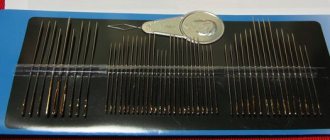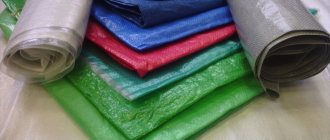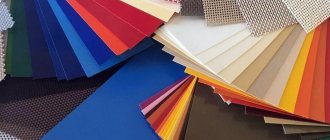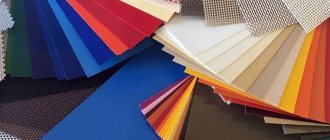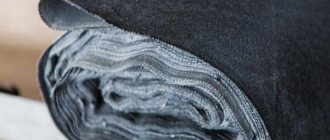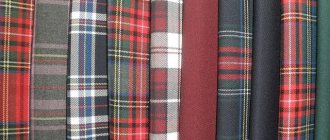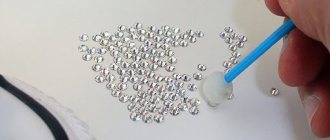Damage to the awning on a truck is an undesirable defect that will have to be corrected in any case. When used correctly, curtain material has an unlimited service life. The fabric is used regardless of weather conditions - wind, rain, cold, heat - it doesn’t matter.
Over time, cracks, tears, and holes appear at the places where the material bends. Regardless of the quality of the coating used, it wears out and requires repair work. Therefore, every driver should know how to seal a tent on a truck.
This will be discussed in the article.
Ways to restore the integrity of the awning
There are several procedures.
Work to restore the integrity of the material is divided into categories:
- Repair of minor defects - performed for minor damage that can be corrected by using a hair dryer, tape or glue. The goal of the work being carried out is to prevent the gap from increasing.
- Medium (emergency) repair – replacement of small parts of the awning using pieces of material that are suitable in color and quality.
- Major – used to repair serious damage, for example, after an accident. Can only be performed in specialized organizations. Requires specialized equipment.
The following materials can be used to repair ruptures or cracks:
- Scotch.
- Construction hairdryer.
- Glue.
Let's talk about each material in more detail.
Scotch
Emergency option. To seal the resulting defects on the awning coverings of trucks, special fabric-based tape is used. One side of it is coated with polymer, the other is treated with an adhesive composition made from rubber.
The color range allows you to choose any color of tape. The temperature ranges from – 20 to +50 C.
Moisture-resistant tape is a suitable option for sealing an awning on a truck. It does not peel off and easily withstands exposure to precipitation.
Construction hair dryer
Another option used when repairing damage to the integrity of the coating. The construction hair dryer is easy to use. The disadvantage is the need to connect to the mains.
In order to properly seal the awning on a truck with a hairdryer, you will need the following materials:
- Fabric - patch. Its composition and color should be similar or identical to the main fabric.
- Pressure roller - preferably with a non-stick coating, since using a hair dryer involves working with high temperatures.
The awning should be sealed on a flat surface. The gluing area is pre-degreased. The edges of the patch are heated and pressed against the material. An additional load is placed on the surface to be glued, which remains on it until the body cover being repaired has completely cooled.
Glue
Using the material to repair a damaged Gazelle awning or other cargo transport is a good option. However, not every mixture is suitable. Before you buy a product, you need to study the instructions and find out whether it is capable of gluing the materials you need. Also find out the temperature conditions at which it does not lose its properties.
Scope of application of PVC fabrics
This material is widely used in production and in everyday life in the manufacture of:
- work and sportswear;
- furniture upholstery;
- travel accessories;
- canopies, awnings, tents;
- exhibition pavilions, car washes, kiosks, summer terraces of cafes;
- awnings for trucks, trailers, boats;
- hangars for aircraft, industrial warehouses, parking lots, grain and vegetable storage facilities;
- protective coverings for swimming pools, gazebos, temporary areas;
- advertising banners, banners, billboards.
Types of glue for truck awnings
The range of mixtures offered today is huge, so it is necessary to choose the right option.
In order to repair the awning covering, the following types of glue can be used:
- For PVC "Vintisk". It is a colorless and very durable mass that produces an invisible seam. Dries at room temperature for 2-3 hours.
- Polyurethane for PVC fabrics – Desmokol. Capable of gluing different surfaces, creating an invisible seam. Its use requires extreme care as it is highly flammable. Carrying out work in close proximity to a fire source is prohibited.
- Cosmofen is a universal adhesive mixture that can connect any types of materials. For correct and reliable operation it is necessary to use a press. It will press the materials being glued and improve the process of their interaction. Withstands temperatures from – 20 to + 80 C.
How to glue an awning - step-by-step instructions
Before work you need to prepare materials:
- A patch of material used to stretch the canopy.
- Glue mixture.
- Strong thread.
- Thick needle, awl.
- Degreaser.
- Roller.
- Hair dryer.
- Rags.
Instructions:
- Sew the gap. This step is necessary to reduce the distance between the parts to be glued and to avoid shifts during the gluing process.
- Clean the surface thoroughly and dry.
- Degrease. This step will help improve the grip.
- Glue is applied to the surface.
- Press the parts together.
- Wait until completely dry. The time is indicated in the instructions for the glue used. Usually at least a day.
How to seal an awning yourself
Repairing curtains with your own hands is not a difficult process, but it does require certain skills. It requires the availability of tools and the execution of technical sequences. Let's talk about this in more detail.
Necessary materials
To carry out repair work on sealing gaps in the awning covering, you will need the following components:
- Glue for truck awning - preferably polyurethane based.
- Industrial hair dryer.
- Roller with non-stick coating.
- Nylon thread - used to connect gaps.
- Surface degreasing liquid – acetone.
- Patches are fabric for repairing damaged areas.
You can't miss at least one detail.
It is important that the awning fabric and patches used have the same or similar density. Otherwise, the repairs performed will not be durable.
Step-by-step instruction
The material used to repair the awning is selected depending on the size and nature of the damage.
Algorithm for performing the work:
- We remove the awning from the car.
- Place on a pre-prepared flat surface.
- We find the place of the break and stitch it with nylon thread.
- We clean the joint of the fabric. You can use sandpaper or special solutions.
- Degrease the edges of the seam and the patch with acetone.
- Apply glue according to the instructions.
- We squeeze the elements tightly or fix them in a vice.
- Let it dry and mount it on the car.
When using thermoplastic glue, the edges of the patch are heated with an industrial hair dryer and rolled with a roller.
If the damage to the fabric is small, they are sealed with tape. In some cases, you can use the services of a studio and sew on patches - this is reliable, but the price is much higher.
The nuances of sealing the awning of a gazelle or truck with your own hands
Features of gluing the hinged base on a gazelle or truck on your own:
- The tears are sewn up with strong thread (fishing line is also used).
- Clean material.
- Degrease the edges around the seam and the patch.
- Apply glue to the hanging fabric and patch.
- Connect the two surfaces, level, and let stand for 5–10 minutes.
- Warm up the gluing area with a hairdryer and roll with a roller.
Not all types of adhesive composition require heating with a hairdryer for adhesion. Proceed according to the instructions.
- Leave for a day.
During the drying period, tent structures are not allowed to be loaded.
Important nuances and recommendations
In order to properly repair a truck awning, you must adhere to the following requirements:
- If the seam diverges, stitch the tear area with nylon thread and treat it with glue.
- Do not neglect cleaning and degreasing the material.
- Watch the edges of the patch you use. They should be smooth and not frayed.
- When carrying out repairs using a hair dryer, you need to monitor the temperature conditions. Otherwise, the material may be burned through.
Repairing an awning cover is not a complicated process. Following the rules will result in a well-repaired surface that will last for many years. If you wish, you can watch the corresponding professional video or video tutorials from experienced people - truck drivers, in which they share their experience and give practical advice.
Detailed information is visible in the video:
Useful tips
Using useful tips during gluing, you can achieve a better result and make the process easier:
- As a patch, use materials of the same quality as the coating.
- The edges of the patch should not fray.
- Do not use tape on the sealing area.
- Be sure to follow the instructions for the glue.
- Degreasing is an important step in the repair process. Without it, the adhesion of materials will be poor.
- If you have doubts about your own abilities or knowledge, it is better to contact the department for repairing awning coverings (gluing PVC fabrics). Since proper sealing will last a long time. This also applies to the moment when there is a constant load on the coating.
- If the awning has split along the seam, then after stitching it is recommended to additionally apply an adhesive composition.
We recommend watching the video instructions:
What advantages do they have?
The widespread use of PVC fabric has become possible due to a number of advantages:
- water-repellent properties ensure tightness without the use of expensive materials in the construction of waterproofing facilities;
- resistance to aggressive substances ensures the safety of PVC fabric even during long-term use in their environment;
- resistance to frost and temperature changes protects the material from cracking and deformation;
- resistance to ultraviolet radiation protects PVC fabric from fading when installed outdoors throughout its entire service life;
- light weight, convenient for installation with your own hands without additional devices, storage, disassembly, transportation for installation in a new location;
- service life is 5 - 7 years even in an aggressive environment under load.
Welding technology
To join PVC fabrics, manual or automatic welding with hot air heated to 700⁰C is mainly used. At higher temperatures, the plastic will decompose.
PVC fabric welding diagram
Thin fabric is welded with an overlap, placing the edges one on top of the other. A stream of hot air is directed between them. When the surfaces are melted, the joint is smoothed with a Teflon or silicone coated roller to prevent the molten material from sticking to it. To increase the strength of the structure, for example, when welding a large banner, the canvases are joined with wide seams in two stages. Start by forming an internal seam at a distance of 1.5 - 2 cm from the edge, then process the gap. The thickness of the monolithic connection is slightly greater than that of the base material, but is not visually noticeable.
For butt welding of thick PVC fabrics, filler material in the form of a polyvinyl chloride rod is used. It is placed between the edges of the canvases. The diameter of the rod is selected depending on the thickness of the fabric and the configuration of the seam. For uniform boiling, a gap of 1 mm is left between the edges of the sheets. A flow of heated air is moved along the joint with transverse movements, achieving uniform melting of the edges and additive. The welding speed depends on the temperature of the air stream and the diameter of the rod. To speed up the process, the fabric and rod are preheated.
Depending on the purpose, types of PVC fabric differ in the method and density of weaving, the thickness of the coating that is applied to one or both sides, and the type of plasticizer. Therefore, before work, it is recommended to make a test on unnecessary sections in order to correctly select the welding method and parameters.
